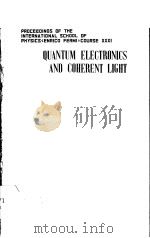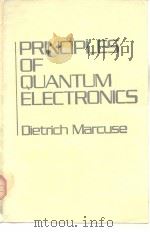《Quantum electronics》求取 ⇩
| 作者 | Amnon Yariv 编者 |
|---|---|
| 出版 | 未查询到或未知 |
| 参考页数 | 676 ✅ 真实服务 非骗流量 ❤️ |
| 出版时间 | 没有确切时间的资料 目录预览 |
| ISBN号 | 无 — 违规投诉 / 求助条款 |
| PDF编号 | 819496658(学习资料 勿作它用) |
| 求助格式 | 扫描PDF(若分多册发行,每次仅能受理1册) |

CHAPTER1 Baslc Theorems and Postulates of Quantum Mechanics1
1.0 Introduction1
1.1 The Schr?dinger Wave Equation1
1.2 The Time-Independent Schrōdinger Wave Equation7
CHAPTER2 Soms Solutions of the Time-lndependent Schrōdinger E?u?tion18
2.0 Introduction18
2.1 Parlty18
2.2 The Harmonic Oscillator19
2.3 The Schrǒdinger Equation in Spherically Symmetric Potential Fields27
2.4 The Angular Momentum Operators and Their Eigenfunctions30
CHAPTER3 Matrix Formulation of Quantum Mechanics34
3.0 Introduction34
3.1 Some Basic Matrix Properties34
3.2 Transformation of a Square Matrix35
3.3 Matrix Diagonalization36
3.4 Representations of Operators as Matrices36
3.5 Transformation of Operator Representations38
3.6 Deriving the Eigenfunctions and Eigenvalues of an Operator by the Matrix Method39
3.7 The Heisenberg Equations of Motion41
3.8 Matrix Elements of the Angular Momentum Operators42
3.9 Spin Angular Momenta45
3.10 Addition of Angular Momentum45
3.11 Time-Independent Perturbation Theory47
3.12 Time-Dependent Perturbation Theory-Relation to Line Broadening50
3.13 Density Matrices-Introduction56
3.14 The Density Matrix56
3.15 The Ensemble Average57
3.16 Time Evolution of the Density Matrix58
3.17 The Time Evolution Operator-Feynman Diagrams58
CHAPTER4 Lattice Vibratione and Their Quantization68
4.0 Introduction68
4.1 Motion of Homogeneous Line68
4.2 Wave Motion of a Line of Similar Atoms69
4.3 A Line with Two Different Atoms71
4.4 Lattice Sums74
4.5 Quantization of the Acoustic Branch of Lattice Vibrations76
4.6 Average Thermal Excitation of Lattice Modes80
CHAPTER5 Electromagnetic Fields and Their Quantization83
5.0 Introduction83
5.1 Power Transport,S?orage,and Dissipation in Electromagnetic Fields83
5.2 Propagation of Electromagnetic Waves in Anisotropic Crystals87
5.3 The Index Ellipsoid90
5.4 Propagation in Uniaxial Crystals92
5.5 Normal Mode Expansion of the Electromagnetic Field in a Resonator94
5.6 The Quantization of the Radiation Field96
5.7 Mode Density and Blackbody Radiation99
5.8 The Coherent State100
CHAPTER6 The P?opa?tion of Optical Beams in Homogeneous and L?e Media106
6.0 Introduction106
6.1 The Lens Waveguide106
6.2 The Identical-Lens Waveguide111
6.3 The Propagation of Rays Between Mirrors111
6.4 Rays in Lenslike Media112
6.5 The Wave Equ?tion in Quadratic Index Media115
6.6 The Gaussian Beam in a Homogeneous Medium116
6.7 The Fundamental Gaussian Beam in a Lenslike Medium-The ABCD Law120
6.8 A Gaussian Beam in a Lens Waveguide123
6.9 High-Order Gaussian Beam Modes in a Homogeneous Medium124
6.10 High-Order Gaussian Beam Modes in Quadratic Index Media125
6.11 Propagation in Media with a Quadratic Gain Profile127
6.12 Elliptic Gaussian Beams129
CHAPTER7 Optical Resonators136
7.0 Introduction136
7.1 Spherical Mirror Resonators136
7.2 Mode Stability (Confinement)Criteria and the Self-Consistent Resonator Solutions141
7.3 The Resonance Frequencies145
7.4 Losses in Optical Resonators147
7.5 Unstable Optical Resonators149
CHAPTER8 Interaction of Radiation and Atomic Systems155
8.0 Introduction155
8.1 Density Matrix Derivation of the Atomic Susceptibility155
8.2 The Significance of X(v)162
8.3 Spontaneous and Induced Transitions164
8.4 The Gain Coefficient169
8.5 The Einstein Treatment of Induced and Spontaneous Transitions171
8.6 Homogeneous and Inhomogeneous Broadening173
8.7 Gain Saturation in Systems with Homogencous and Inhomogeneous Broadening176
CHAPTER9 L?er O?cillation183
9.0 Introduction183
9.1 The Laser Oscillation Condition183
9.2 Laser Oscillation--General Treatment189
9.3 Power Output from Lasers191
CHAPTER10 So? Specific Laser Systems202
10.0 Introduction202
10.1 Pumping and Laser Efficiency202
10.2 The Ruby Laser202
10.3 The Nd3+:YAG Laser208
10.4 The Neodymium-Glass Laser211
10.5 The He-Ne Laser214
10.6 The Carbon Dioxide Laser216
10.7 Organic-Dye Lasers224
CHAPTER11 Semiconductor Diode Lasers232
11.0 Introduction232
11.1 Some Semiconductor Background232
11.2 Optically Induced Band-to-Band Transitions in Semiconductors236
11.3 Diode Lasers243
11.4 GaInAsP Lasers251
11.5 Some Real Lasers251
11.6 Direct-Current Modulation of Semiconductor Lasers255
CHAPTER12 Quantu? Well Lasers264
12.0 Introduction264
12.1 The Quantum Mechanics264
12.2 Gain in Quantum Well Lasers269
12.3 Some Numerical Considerations271
CHAPTER13 The Free-Electron Laser277
13.0 Introduction277
13.1 The Kinematics of Free-Electron-Photon Interaction277
13.2 Theory of Optical Gain in Free-Electron Lasers283
13.3 The Pondermotive Potential289
CHAPTER14 The Modulation of Optical Radiation298
14.0 Introduction298
14.1 The Electrooptic Effect298
14.2 Electrooptic Retardation307
14.3 Electrooptic Amplitude Modulation310
14.4 Phase Modulation of Light313
14.5 Transverse Electrooptic Modulators315
14.6 High-Frequency Modulation Considerations318
14.7 Eiectrooptic Beam Deflection323
14.8 The Photoelastic Effect325
14.9 Bragg Diffraction of Light by Acoustic Waves327
14.10 Deflection of Light by Sound335
14.11 Bragg Scattering in Naturally Birefringent Crystals337
CHAPTER15 Coherent Interactions of a Radiation Fieid and An Atomic Sy?tem342
15.0 Introduction342
15.1 Vector Representation of the Interaction of a Radiation Field with a Two-Level Atomic System342
15.2 Superradiance352
15.3 Photon Echoes355
15.4 Self-Induced Transparency357
CHAPTER16 Introduction to Nonlinear Optics-Second-Harmonlc G?n?tion378
16.0 Introduction378
16.1 The Nonlinear Optical Susceptibility Tensor379
16.2 The Nonlinear Field Hamiltonian383
16.3 On the Physical Origins of the Nonllnear Optical Coefficlents384
16.4 The Electrmagnetic Formulation of the Nonlinear Interaction389
16.5 Optical Second-Harmonic Generation392
16.6 Second-Harmonic Generation with a Depleted Input398
16.7 Second-Harmonic Generation with Gaussian Beams400
16.8 Internal Second-Harmonic Generation402
CHAPTER17P Parametric Amplification,Oscillation,and Fluorescence407
17.0 Introduction and Lumped Circuit Analog407
17.1 The Basic Equations of Parametric Amplification409
17.2 Parametric Oscillation411
17.3 Power Output and Pump Saturation in Parametric Oscillators418
17.4 Frequency Turning in Parametric Oscillation419
17.5 Quantum Mechanical Treatment of Parametric Interactions421
17.6 Frequency Up-Conversion425
17.7 Spontaneous Parametric Fluoresceoce430
17.8 Backward Parametric Amplification and Oscillation435
17.9 Squeezed States of the Electromagnetic Field437
CHAPTER18 Third-Order Optical Nonlinearities--Stimulated Raman and Brillouin Scattering453
18.0 Introduction453
18.1 The Nonlinear Constants453
18.2 molecular Raman Scattering457
18.3 Stimulated Molecular Raman Scattering465
18.4 Electromagnetic Treatment of Stimulated Raman Scattering469
18.5 Anti-Stokes Scattering473
18.6 Stimulated Brillouin Scattering475
18.7 A Classical Treatment of Brillouin Scattering475
18.8 Self-Focusing of Optical Beams482
CHAPTER19 P?-Conjugate-Optics and Photorefractive Beam Coupling495
19.0 Introduction495
19.1 Propagation Through a Distorting Medium495
19.2 Image Transmission in Fibers495
19.3 Theory of Phase Conjugation by Four-Wave Mixing498
19.4 Optical Resonators with Phase-Conjugate Reflectors506
19.5 The ABCD Formalism of Phase-Conjugate Optical Resonators507
19.6 Some Practical Applications of Phase Conjugation510
19.7 Optical Phase Conjuation by Stimulated Nonlinear Scattering513
19.8 Beam Coupling and Phase Conjugation by the Photorefractive Effect516
CHAPTER20 Q-Switching and Mode Locking of Lasers534
20.0 Introduction534
20.1 Q-Switching534
20.2 Mode Locking in Inhomogeneously Broadened Laser Systems542
20.3 Mode Locking in Homogeneously Broadened Laser Systems553
20.4 Relaxation Oscillation in Lasers560
20.5 Passive Mode Locking565
CHAPTER21 Noise and Spectra of Laser Amplifiers and O?cillators570
21.0 Introduction570
21.1 Noise in Laser Amplifiers570
21.2 Spontaneous Emission Noise in Laser Oscillators577
21.3 Some Mathematical Background582
21.4 The Laser Equations584
21.5 The Laser Spectra586
21.6 The Laser Spectra Experiments592
21.7 The a Parameter594
21.8 The Measurement of(Δv)laset596
CHAPTER22 Guided Wave Optics-Propagation in Optical Fibers600
22.0 Introduction600
22.1 The Waveguide Modes600
22.2 Mode Characteristics of the Planar Waveguide603
22.3 Goupling Between Guided Modes606
22.4 The Periodic Waveguide--Distributed Feedback Lasers608
22.5 The Coupled-Mode Solutions611
22.6 The Distributed Feedback Laser615
22.7 Electrooptic Modulation and Mode Coupling in Dielectric Waveguides623
22.8 Directional Coupling-Supermodes627
22.9 The Eigenmodes of a Coupled Waveguide System( Supermodes )631
22.10 Propagation in Optical Fibers640
APPENDIX1 The Kramer?-Kronlg Relations651
APPENDIX2 Solid Angle Associated with a Blackbody Mode653
APPENDIX3 The Spontaneous Emission Lifetime for a Vibrational-Rotational Transition in a Linear Molecule655
APPENDIX4 Quantum Mechanical Derivation of Nonlinear Optical Constants658
APPENDIX5 The Interaction of An Electron and An Electromagnetic Field663
APPENDIX6 The Derivation of the Spontaneous Emission Langevin Fluctuation“Power”666
Index669
《Quantum electronics》由于是年代较久的资料都绝版了,几乎不可能购买到实物。如果大家为了学习确实需要,可向博主求助其电子版PDF文件。对合法合规的求助,我会当即受理并将下载地址发送给你。
高度相关资料
-

- QUANTUM ELECTRONICS AND COHERENT LIGHT
- ACADEMIC PRESS
-

- ADVANCES IN QUANTUM ELECTRONICS VOLUME 3
- 1975 ACADEMIC PRESS LONDON AND NEW YORK
-

- PHYSICS OF QUANTUM ELECTRONICS CONFERENCE PROCEEDINGS
- 1966 McGRAW-HILL BOOK COMPANY
-

- ADVANCES IN QUANTUM ELECTRONICS VOLUME 1
- 1970 ACADEMIC PRESS LONDON AND NEW YORK
-

- RADIATION AND NOISE IN QUANTUM ELECTRONICS
- 1964 MCGRAW-HILL BOOK COMPANY
-

- QUANTUM ELECTRONICS VOLUME 1 PART 2
- 1964 COLUMBIA UNIVERSITY PRESS
-

- QUANTUM ELECTRONICS A SYMPOSIUM
- 1960 COLUMBIA UNIVERSITY PRESS
-

- OPTICAL COMMUNICATION SYSTEMS
- 1984 PRENTICE/HALL INTERNATIONAL
-

- QUANTUM ELECTRONICS THIRD EDITION
- 1989 JOHN WILEY & SONS
-

- INTRODUCTION TO QUANTUM ELECTRONICS
- ACADEMIC PRESS
提示:百度云已更名为百度网盘(百度盘),天翼云盘、微盘下载地址……暂未提供。➥ PDF文字可复制化或转WORD



